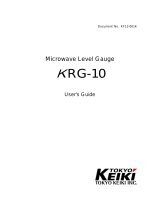
6
Instruments and applications
Radar
29019-US-180913
3 Instruments and applications
VEGAPULSWL61
VEGAPULS WL 61 is the ideal sensor for all applications in water and sew-
age water applications. It is particularly suitable for use in water processing,
pump stations as well as overow basins, for ow measurement in open
umes and gauge monitoring. VEGAPULS WL 61 provides an economical
solution through versatile and simple mounting options. The ood-proof
IP 68 housing ensures continuous, maintenance-free operation.
VEGAPULS61
The VEGAPULS 61 is a sensor for continuous level measurement of liquids
under simple process conditions. Due to its simple and versatile mounting
options, VEGAPULS 61 oers a truly cost-eective solution. The encapsu-
lated antenna system ensures maintenance-free operation.
The version with encapsulated antenna system is particularly suitable for
level measurement of aggressive liquids in small vessels. The version with
plastic horn antenna is particularly suitable for ow measurement in open
umes or gauge measurement of open waters.
VEGAPULS62
VEGAPULS 62 is a universally implementable sensor for continuous level
measurement of liquids. It is suitable for level measurement in storage
containers, reactors and process vessels, even under dicult process
conditions. With its various antenna versions and materials, VEGAPULS 62
is the optimal solution for almost all applications and processes. Its wide
temperature and pressure range makes project planning simple.
The version with horn antenna is particularly suitable for storage tanks and
process vessels for measurement of products like solvents, hydrocarbons
and fuels. The version with parabolic antenna is particularly suitable for
measurement of products with low ε
r
value at large measuring distances.
VEGAPULS63
The VEGAPULS 63 is a sensor for continuous level measurement of
aggressive liquids or liquids with hygienic requirements. It is suitable for
applications in storage tanks, process vessels, dosing vessels and reactors.
The encapsulated antenna system of VEGAPULS 63 protects against
pollution and ensures continuous, maintenance-free operation. Front-ush
mounting ensures optimum cleanability even in case of the most stringent
hygienic requirements.
VEGAPULS64
The VEGAPULS 64 is a radar sensor for continuous level measurement of
liquids.
Special advantages result from the small process ttings for small tanks
and the very good focussing in applications in large tanks. This is made
possible by the high emitting frequency of 80 GHz with an especially small
beam angle.
VEGAPULS65
The VEGAPULS 65 is a radar sensor for continuous measurement of
liquids under simple process conditions. It is particularly suitable for level
measurement in vessels with small process ttings and simple process
conditions. The slim rod antenna allows installation in small vessel open-
ings.
VEGAPULS66
The VEGAPULS 66 is a radar sensor for continuous level measurement
of liquids under dicult process conditions. It is suitable for applications in
storage tanks, process vessels or standpipes. VEGAPULS 66 can be used
universally thanks to its dierent antenna versions.
Application areas
The radar sensors of the VEGAPULS series described in this manual are
used for non-contact level measurement of liquids. They measure all kinds
of liquids, even under high pressure and at extreme temperatures. The
sensors can be used in simple but also aggressive liquids and are suitable
for applications with maximum hygienic requirements.
Levelmeasurementinvessels
For level measurement in vessels with conical bottom it can be advanta-
geous to mount the sensor in the centre of the vessel, as measurement is
then possible down to the bottom.
Fig. 9: Level measurement in vessels with conical bottom
Measurement in a surge pipe
By using a surge pipe in the vessel, inuences from internal vessel
installations and turbulence can be excluded. Under these prerequisites,
the measurement of products with low dielectric values (ε
r
value ≥ 1.6) is
possible. In very adhesive products, measurement in a surge pipe is not
recommended.
0%
100%
1
2
3
1
2
3
4
5
8
6
7
9
Fig. 10: Conguration surge pipe
1 Radar sensor
2 Polarisation marking
3 Thread or ange on the instrument
4 Vent hole
5 Holes
6 Weld joint
7 Welding neck ange
8 Ball valve with complete opening
9 Fastening of the surge pipe
Flow measurement
Flow measurement in open umes with a dened constriction, such as e.g.
a rectangular overow, can be realized with a level measurement.























